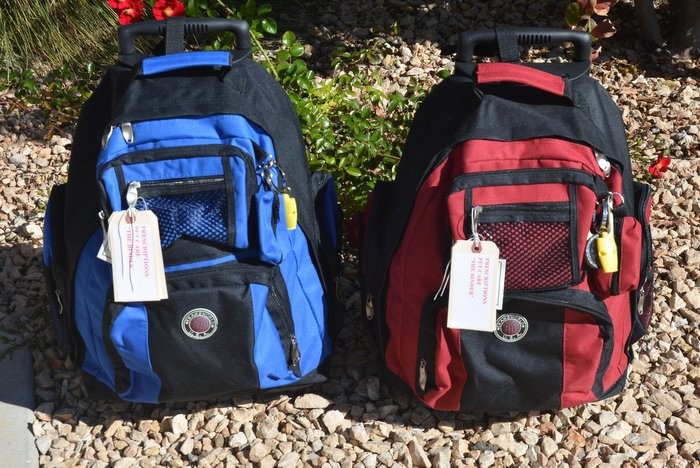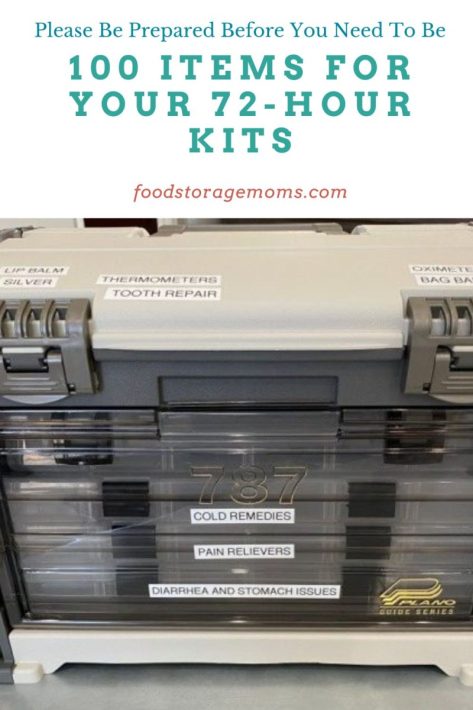
Here’s a comprehensive, organized list of 100 Items For Your 72-Hour Kits — everything you might need to survive and stay comfortable for at least three days in an emergency.
A 72-hour kit (also called a go-bag or bug-out bag) should sustain you for three days during an evacuation, disaster, or emergency. Each family member, even pets, should have their own kit for survival, comfort, hygiene, and peace of mind.
100 Items For Your 72-Hour Kits
My favorite items to put in my bags are on this limited list, but you will get the drift.
First Aid Kits (these fit in your bags)

100 Items For Your 72-Hour Kits
Food & Water
The priority in any emergency is hydration and nourishment. Your body needs a steady supply of energy to stay alert and decisive.
- Bottled water (1 gallon per person per day). Please note: I prefer 4 gallons per person per day.
- Water purification tablets
- Portable water filter (LifeStraw or Sawyer Mini)
- Collapsible water container
- Canned meals (stews, soups, chili)
- Canned fruit or vegetables
- Ready-to-eat meals (MREs)
- Energy or protein bars
- Trail mix or nuts
- Instant oatmeal packets
- Peanut butter
- Crackers
- Powdered milk
- Instant coffee or tea
- Hard candy or gum
- Disposable utensils
- Can opener (manual)
- Small cooking pot or pan
- Camping stove or solid fuel stove, Kelley Kettle
- Fuel canisters (propane, butane, or tabs) Butane Stove, and Canisters
First Aid & Health
A well-stocked first aid kit can prevent infections and save lives during a crisis.
- Adhesive bandages (various sizes)
- Sterile gauze pads
- Medical tape
- Antiseptic wipes
- Antibiotic ointment
- Tweezers
- Scissors
- Pain relievers (ibuprofen, acetaminophen)
- Antihistamines (for allergies)
- Burn cream or gel
- Instant cold packs
- Elastic bandage wrap
- Nitrile gloves
- Thermometer
- Prescription medications (3-day supply minimum)
- Eye drops
- Lip balm
- Face masks (N95 if possible)
- Hand sanitizer
- Small first-aid manual
Clothing & Warmth
Your clothing choices can mean the difference between comfort and danger in extreme conditions.
- Extra set of clothes (season-appropriate)
- Warm jacket or coat
- Rain poncho
- Sturdy shoes or boots
- Extra socks (at least two pairs)
- Hat and gloves
- Bandana or scarf
- Mylar emergency blanket
- Sleeping bag
- Compact sleeping pad
Tools & Gear
These items help with shelter building, signaling, and safety.
- Multi-tool or Swiss Army knife
- Duct tape
- Rope or paracord (at least 25 feet)
- Flashlight (LED preferred)
- Extra batteries
- Solar or hand-crank lantern
- Whistle
- Compass
- Waterproof matches
- Lighter
- Firestarter (cotton balls & petroleum jelly)
- Small shovel or trowel
- Pocket saw or folding knife
- Zip ties
- Glow sticks
- Super glue
- Safety pins
- Small sewing kit
- Trash bags (heavy-duty)
- Carabiners or clips
Hygiene & Sanitation
Cleanliness helps maintain morale and prevents disease, especially in group or shelter settings.
- Toothbrush & toothpaste
- Biodegradable soap
- Wet wipes
- Towel or washcloth
- Deodorant
- Comb or brush
- Razor & shaving cream
- Toilet paper
- Feminine hygiene products
- Small mirror
- Plastic bags (for waste)
- Portable toilet or disposable bags
- Hand sanitizer (extra bottle)
- Laundry soap sheets or powder
- Nail clippers
Communication & Documentation
Stay informed and connected when networks are down.
- Battery-powered or hand-crank radio
- Cell phone charger (solar or crank type)
- Extra power bank
- List of emergency contacts
- Copies of ID, insurance, and medical info (in waterproof pouch)
- Cash (small bills)
- Local maps
- Notebook and pen/pencil
- Sharpie marker
- Small Bible or inspirational book
Comfort & Extras
A few comfort items go a long way in reducing stress during emergencies.
- Deck of cards or small game
- Small book or puzzle
- Earplugs
- Lightweight tent or tarp
- Pet food and supplies (if applicable)
When Would You Need To Use Your 72-Hour Kit
1. Natural Disasters
Your 72-hour kit is essential if you need to evacuate quickly or shelter in place during:
- Earthquakes: Power, water, and roads may be unavailable for days.
- Hurricanes or tornadoes: You may need to leave your home suddenly or stay in a shelter.
- Flooding or wildfires: Often requires immediate evacuation with little warning.
- Severe winter storms: Roads may close and power outages can last for days.
2. Power Outages or Utility Failures
If electricity, water, or gas service is interrupted for more than a few hours:
- Your kit provides flashlights, batteries, food, water, and warmth.
- It helps you stay comfortable and safe without needing to leave your home.
3. Evacuation Orders
Authorities may tell you to leave your area due to:
- Chemical spills or industrial accidents
- Train derailments
- Civil unrest or safety threats
Having your kit packed lets you leave within minutes with everything essential — ID, cash, meds, and food.
4. Stranded While Traveling
If you’re stuck in your car during a snowstorm or a highway closure:
- A small 72-hour kit (kept in your trunk) provides blankets, food, and light until help arrives.
5. Family or Medical Emergencies
In case you must leave home suddenly, for example, to stay with relatives or go to a hospital, your 72-hour kit ensures you have:
- Prescriptions, hygiene supplies, clothes, phone chargers, and personal items are ready to go.
6. Shelter-In-Place Scenarios
Sometimes, it’s safer to stay inside your home rather than evacuate, like after a chemical release or during a widespread power outage.
Your 72-hour kit helps you sustain yourself for three days without leaving your home.
FAQs About 72-Hour Kits
1. What is a 72-hour kit?
A 72-hour kit (or go-bag) is a portable emergency kit designed to sustain you for three days with essential food, water, medical supplies, and survival essentials.
2. Why 72 hours?
Most disaster-response organizations aim to reach victims within 72 hours, so you need enough supplies to stay self-sufficient until help arrives.
3. How often should I update my kit?
Check and replace expired food, water, and medications every 6 months. Update clothing and gear for the season.
4. Should each family member have their own kit?
Yes, tailor each kit for age, size, and medical needs. Even pets should have a mini 72-hour kit.
5. Where should I store my 72-hour kits?
Please keep them in an easily accessible place near your front door, car trunk, or emergency shelter area.
1. Emergency Shelters (Run by Red Cross, FEMA, or Local Agencies)
After most disasters, emergency shelters are among the first to open.
They’re usually located in:
- Schools
- Community centers
- Churches
- Convention centers
- Sports arenas
Tip:
Listen to local radio or emergency alerts for official shelter locations.
Never assume your local school or church will open automatically — some may be damaged or inaccessible.
2. Hospitals and Medical Centers
If you or a family member is injured, go to the nearest hospital, urgent care, or first-aid station set up by local responders.
During large-scale disasters, temporary medical tents or mobile units may be placed in:
- High school parking lots
- Fairgrounds
- Sports complexes
Bring your ID, insurance info, and medications from your 72-hour kit, if possible.
3. Police or Fire Stations
These serve as command centers during emergencies.
You can go there if you:
- Need safety from danger or crime
- Are lost or separated from your family
- Need to report missing persons or property damage
Note: They may not offer shelter, but they can direct you to available resources.
4. Designated Evacuation Centers
Counties often have pre-approved evacuation buildings that are built to withstand local hazards (like earthquakes or hurricanes).
Examples include:
- City recreation centers
- Municipal buildings
- Armories
You can find your nearest evacuation centers by checking your:
5. Faith-Based or Nonprofit Shelters
Many churches, mosques, temples, and community organizations open their doors during disasters — especially if government shelters are full.
Groups like:
- The Salvation Army
- Catholic Charities
- Local community coalitions
These often provide food, water, and temporary lodging.
6. Hotels or Motels (If Safe and Affordable)
If you can afford it and travel is safe, a hotel can offer privacy and comfort while infrastructure is restored.
Always check:
- Power availability
- Clean water access
- Safety of the surrounding area
7. Family, Friends, or Out-of-Area Contacts
If possible, it’s best to evacuate to someone you trust who lives outside the disaster zone.
This is where your family emergency communication plan comes in.
Make sure every family member knows:
- The address and phone number of your out-of-area contact
- How to send updates via text (texts often work when calls fail)
8. Last Resort: Open Areas or Temporary Camps
If all else fails and buildings are unsafe, go to:
- Open parks
- School fields
- Large parking lots
These areas are often used for:
- Helicopter landings
- Temporary aid stations
- Supply drop zones
Stay until authorities establish an official shelter.
72-Hour Bags Needed For Survival
PRINTABLE: 100 Items For Your 72 Hour Kit
100_Items_For_Your_72_Hour_Kits_ChecklistFinal Word
After a disaster:
Stay calm and check for immediate danger (gas leaks, fires, unstable structures).
Listen to official instructions via radio or phone alerts.
Go to a designated safe building, don’t wait until nightfall.
Bring your 72-hour kit with you wherever you go. Your 72-hour kit is your lifeline when disaster strikes, whether you’re sheltering in place or evacuating. Review and rotate supplies every 6 months to ensure everything stays fresh and functional. Customize kits for each family member’s age, health, and personal needs. May God bless this world, Linda
The post 100 Items For Your 72-Hour Kits appeared first on Food Storage Moms.
from Food Storage Moms
No comments:
Post a Comment